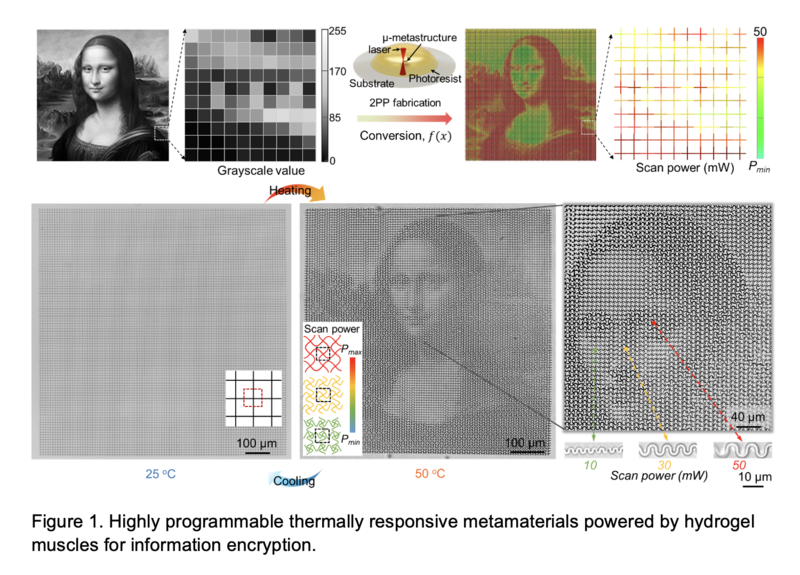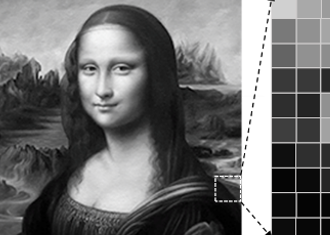Blog: Shaping the future: Hydrogel muscles empowering advanced information encryption
- 22 August 2023
- Physical Intelligence
Recent research led by Professor Metin Sitti at the Physical Intelligence Department of the Max Planck Institute for Intelligent Systems has introduced an innovative strategy for achieving precise transformations of microscale metastructures actuated by hydrogel artificial muscles.
Author: Mingchao Zhang
In the realm of fiction, characters like Mystique from the X-Men series possess extraordinary shape-shifting abilities, allowing them to seamlessly alter their appearance and form. These fantastical elements have fueled our imagination, making us wonder if such complex metamorphosis could ever be achieved in reality. While there are not mutants with superpowers, scientists are making remarkable strides in the realm of controlled shape-changing materials.
The pursuit of controllable shape deformations has been a long-standing goal for researchers. Advances in materials science have yielded breakthroughs such as shape-memory alloys and programmable polymers. These materials can undergo changes in appearance and form upon exposure to specific stimuli, such as temperature, magnetic fields, or electric fields. While the transition from one configuration to another is relatively achievable, achieving versatiletransformations from a single starting configuration remains a formidable challenge.
Recent research led by Professor Metin Sitti at the Physical Intelligence Department of the Max Planck Institute for Intelligent Systems has introduced an innovative strategy for achieving precise transformations of microscale metastructures actuated by hydrogel artificial muscles. Their findings, published in the latest issue of Nature Materials, showcase hydrogels as a driving strategy for shape-shifting metastructures (which possess large quantities of repeating building units).
Hydrogels, known for their water-adaptive properties, controllable chemistry, and biocompatibility, hold enormous promise in soft robotics, implantable devices, and biomedical applications. To harness hydrogels as artificial muscles, they must exhibit high transparency, uniform deformability, and large deformation capabilities. Uniform deformation of hydrogel muscles ensures an even driving of structural units, while high transparency allows real-time optical observation of their structural transformations. We developed such a hydrogel by copolymerizing the responsive polymer skeleton with two hydrophilic monomers (i.e., ternary copolymerization approach). This way prevents the collapse of their hydrophobic polymer chains, which previously leads to nonuniform deformation and opacity during the transition.
Using two-photon 3D printing, we created structures with sub-micrometer precision and embedded them into the hydrogel muscles. The basic mechanism of transformation involves the hydrogel uniformly contracting upon heating, causing these rigid printed structures to buckle into wave-like patterns. Reverting to room temperature restores their original state. By manipulating printing processing parameters, such as printing powers and speeds, we achieved both globally uniform and locally diverse transformation of the metastructures. This strategy applied not only to the transformation of complex 2D structures but also to intricate 3D microstructures.

We encoded the grayscale information of the famous painting Mona Lisa into the 3D printing process, demonstrating how heating transformed the meta-lattice into various local details, bringing the artwork to life (Figure 1). Furthermore, we discovered that the printed basic units exhibited programmable optical anisotropy, providing them another channel for information loading. By controlling the printing angle of units during the transformation, iconic artworks like Girl with a Pearl Earring could be loaded onto these metastructure lattices, revealing or concealing the complex image based on temperature-induced structural deformations.
While the concept of flawless shape-shifting, as seen in the X-Men series, remains a distant dream due to current material properties and physical limitations, researchers are exploring interdisciplinary fields such as materials science, robotics, and intelligent control to unlock the potential for diverse and multifunctional transformations. The journey from fiction to reality may be long, but each breakthrough brings us a step closer to turning the fantastical into the feasible.
Disclaimer: The blog posts on this website are written by researchers affiliated with the Max Planck Institute for Intelligent Systems. The views and opinions expressed in these posts are those of the authors and do not necessarily reflect the official policy or position of the Max Planck Institute for Intelligent Systems or the Max Planck Society. The posts are intended to share the research findings and insights of the authors and to stimulate discussion and debate among the academic community and the public. The authors are solely responsible for the accuracy, completeness, and validity of the information presented in their posts.
hydrogel muscles; artificial muscles; soft robotics







